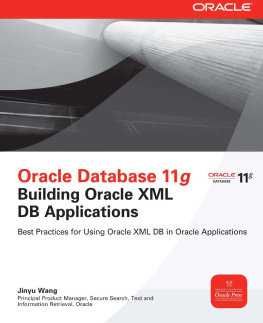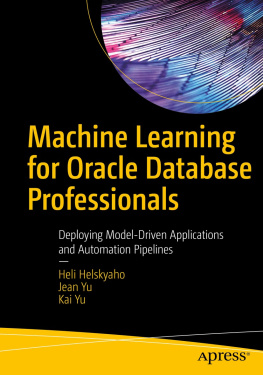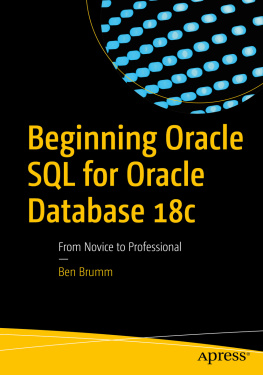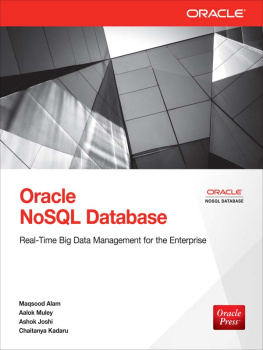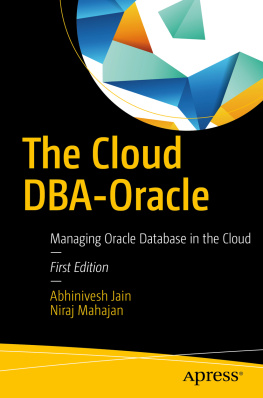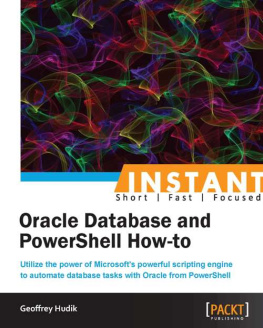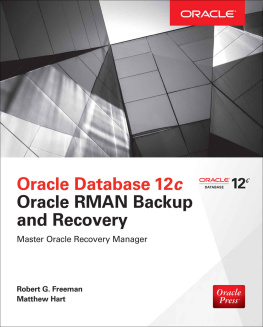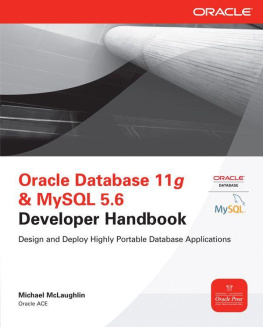In the real world, the foundation of everything we think about and do is data. Our brains organize data by patterns, which is another way of saying sets. In the virtual world of programming, its still all about data. But now we have to build and manage the sets of data ourselves. We can and should use the SQL language as our means of communication, but even before that, weve got to make sure the data is organized so that it accurately captures entities and expresses the relationships between them. Skip or do a poor job at database design, and everything else in your application development process will suffer. Do it right, and everything that follows is more intuitive, easier to build, and much easier to maintain.
With long and deep experience, Heli has written an ideal guide to both database design and Oracle SQL Developer Data Modeler.
Steven Feuerstein
Architect, Oracle Corporation
Working as a database administrator and developer, one of the hardest problems you encounter is coming late to a project that is suffering from performance problems. In many cases the problems are caused by fundamental flaws in the database design. Identify these too late in the development process and the job of redesigning the database and refactoring the associated code can be a huge problem.
Over the last 30+ years programming paradigms have come and gone, but data has remained king. Regardless of your chosen development methodology, if you are planning to use a relational database, you have little choice but to spend time on the design phase. Trying to cut corners will always results in problems later.
Tim Hall
Oracle ACE Director
Database Administrator, Developer, and Author
http://oracle-base.com
Data modeling is critical to success. Data modeling and data design are now more important than ever. With the onslaught of big data, our job is even more critical; turning data into information is a necessary task and cannot be accomplished without understanding what the structure of the data really is. If we do not turn our focus to understanding the structures of the data, then we cannot properly identify it or make sense of it, much less turn it into information that the business can utilize.
Dan Linstedt
Founder and CEO
http://LearnDataVault.com
Enterprise applications are used to enable business. A great application not only supports a process but allows the organization to understand what is happening and allows it to respond. Key to all this is the data, and a well-designed database allows that access and flexibility.
My reality is that whenever I have struggled to get the information I need from an application, it has been because of poor database design. This book will help reinforce the need for good-quality database design.
Debra Lilley
ACE Director
The idea of producing a formal database design is regarded by many as being old-fashioned these days. However, from my 25+ years experience of working in the field of database performance, I do see a clear correlation between the time spent designing a database up front to meet the functional requirements and the chance of success of the project. The correlation in the other direction is even clearer; if time is not invested in understanding the requirements of the application system and in understanding the database that stores its data, then the chances of building a system that meets user requirements is small, and the probability of heading off on a tangent from the core requirements is greatly increased. Performance cannot be retrofitted to a system; it has to be designed in.
Using tools to help automate the design process, as recommended in this book, reduces the time needed for the design stage and makes it less likely that there will be a temptation to short the design stage. And that has to be better for everyone.
Graham Wood
Architect
Oracle Corporation
Copyright 2015 by McGraw-Hill Education (Publisher). All rights reserved. Except as permitted under the United States Copyright Act of 1976, no part of this publication may be reproduced or distributed in any form or by any means, or stored in a database or retrieval system, without the prior written permission of the publisher.
ISBN: 978-0-07-185010-0
MHID: 0-07-185010-4
The material in this eBook also appears in the print version of this title: ISBN: 978-0-07-185009-4,
MHID: 0-07-185009-0.
eBook conversion by codeMantra
Version 1.0
All trademarks are trademarks of their respective owners. Rather than put a trademark symbol after every occurrence of a trademarked name, we use names in an editorial fashion only, and to the benefit of the trademark owner, with no intention of infringement of the trademark. Where such designations appear in this book, they have been printed with initial caps.
McGraw-Hill Education eBooks are available at special quantity discounts to use as premiums and sales promotions or for use in corporate training programs. To contact a representative, please visit the Contact Us page at www.mhprofessional.com.
Oracle and Java are registered trademarks of Oracle Corporation and/or its affiliates. All other trademarks are the property of their respective owners, and McGraw-Hill Education makes no claim of ownership by the mention of products that contain these marks.
Screen displays of copyrighted Oracle software programs have been reproduced herein with the permission of Oracle Corporation and/or its affiliates.
Oracle Corporation does not make any representations or warranties as to the accuracy, adequacy, or completeness of any information contained in this Work, and is not responsible for any errors or omissions.
TERMS OF USE
This is a copyrighted work and McGraw-Hill Education and its licensors reserve all rights in and to the work. Use of this work is subject to these terms. Except as permitted under the Copyright Act of 1976 and the right to store and retrieve one copy of the work, you may not decompile, disassemble, reverse engineer, reproduce, modify, create derivative works based upon, transmit, distribute, disseminate, sell, publish or sublicense the work or any part of it without McGraw-Hill Educations prior consent. You may use the work for your own noncommercial and personal use; any other use of the work is strictly prohibited. Your right to use the work may be terminated if you fail to comply with these terms.
THE WORK IS PROVIDED AS IS. McGRAW-HILL EDUCATION AND ITS LICENSORS MAKE NO GUARANTEES OR WARRANTIES AS TO THE ACCURACY, ADEQUACY OR COMPLETENESS OF OR RESULTS TO BE OBTAINED FROM USING THE WORK, INCLUDING ANY INFORMATION THAT CAN BE ACCESSED THROUGH THE WORK VIA HYPERLINK OR OTHERWISE, AND EXPRESSLY DISCLAIM ANY WARRANTY, EXPRESS OR IMPLIED, INCLUDING BUT NOT LIMITED TO IMPLIED WARRANTIES OF MERCHANTABILITY OR FITNESS FOR A PARTICULAR PURPOSE. McGraw-Hill Education and its licensors do not warrant or guarantee that the functions contained in the work will meet your requirements or that its operation will be uninterrupted or error free. Neither McGraw-Hill Education nor its licensors shall be liable to you or anyone else for any inaccuracy, error or omission, regardless of cause, in the work or for any damages resulting therefrom. McGraw-Hill Education has no responsibility for the content of any information accessed through the work. Under no circumstances shall McGraw-Hill Education and/or its licensors be liable for any indirect, incidental, special, punitive, consequential or similar damages that result from the use of or inability to use the work, even if any of them has been advised of the possibility of such damages. This limitation of liability shall apply to any claim or cause whatsoever whether such claim or cause arises in contract, tort or otherwise.
Next page

